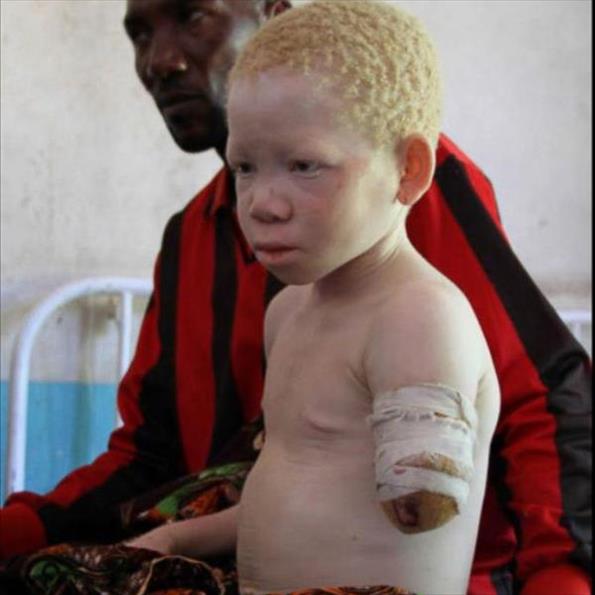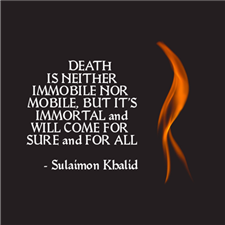Chinedu Dike's Profile
Albinos On The Razor-edge Of Danger

At the behest of witch doctors headhunters are on the prowl.
They're watching, waiting, stalking and avoiding detection,
in hope of an ambush with a brutal ferocity.
Their bowie knives, and their gruesome machetes,
as sharp as a guillotine blade that is poised for execution,
certain to dismember any unfortunate victim
into chunks of bleeding flesh in a matter of seconds.
Faced with the looming menace many albinistic
persons are housebound in their homes,
swallowed up by anxiety and depression,
in a sustained state of fear for their own safety
and a deep sense of distrust for fellow beings.
But whenever compelled by a crucial necessity,
they would nervously venture out nonetheless.
Such unavoidable runs, risky as hell, can easily
deliver them into the grasps of the cruel fate.
The horrific butchering of persons with albinism
in some parts of Africa, with a single purpose
of harvesting their blood, internal organs,
and other body parts for sacrificial rituals,
has left so many of them revoltingly beheaded;
limps cut off; ears, breasts, and genitals sliced off;
hearts, kidneys, livers, and eyes gouged out —
while victims were still alive in many cases.
Some albinos are also known to have been
buried alive, as human-offerings, to appease
blood-thirsty deities or spirits. Even the ones
who are already deceased and interred are not
left to rest in peace, as their remains are being
dug up and robbed of hair, teeth and bones.
Myths have it that the blood, organs, and other
body parts of the albino can be used to harness
magical powers; that they are known to yield
powerful outcomes when used as ingredients
in preparing portions, charms or amulets, that
can bring riches, provide fortification against
harm, infuse extraordinary powers, or exorcise
ancestral wrath believed to be the root-cause of
the existential anxieties of those who use them.
In those African societies that seem full of myths
and witchcraft, the notion that albinistic people
are endowed with mystical powers is one that
is deeply entrenched in the public perception.
As old as generations this harmful superstition
is what, in recent years, increasing numbers of
sorcerers and criminal charlatans draw on to
trick people into the illusion of human sacrifice.
To validate the efficacy claims of such a weird
practice, these black magicians and con-artists,
who act as both traditional healers and holymen,
translate the existing legends and folklores
on potency of albino in dark magic into terms
that make sense to those who consult them.
Quite keen on making merchandise of persons
with albinism, the so-called witch doctors have
put a price on their heads — thus assigning
a commercial value to members of the group
in the eyes of predatory individuals, who are
lured into the clandestine trade in albinos
and their body parts to make quick money.
The tragic outcome of this bounty on albinos —
dead or alive, adults or children, is the rise of
criminal networks that revolve around witch
doctors, including scouters, body snatchers,
kidnappers, traffickers, killers, and others
who also play their part in sinister schemes
set up by the juju men to feather their nests
at the expense of their clients' murky motives.
The ritual murders of albinos in these societies
remain largely a crime driven by a boundless
quest to gratify out of reach gnawing-desires,
coupled with the widespread beliefs that such
sacrificial rituals work. These superstitions are
by no means limited to the chiefly uneducated,
poor masses, since so many of the clients who
patronize the greedy witch-doctors are people
of means from many different walks of life —
mostly those politicians and entrepreneurs
who believe that lucky talismans made from
albino body parts can make them win elections,
or usher in an era of boom in their business
ventures, by bewitching voters or prospects into
favouring their candidacies, goods or services.
This belief that people with albinism possess
special powers, that can bring success in just
about everything, is nothing short of lethal.
In the rural areas of some African countries
where everything that happens, whether
good or bad, is directly associated with the
intervention of the spirits, vicious onslaught
on albinistic persons appears to be rampant.
They are being hunted down and slaughtered
like animals by ritualistic criminals, who are all
linked to the trafficking networks contracted
or established by the traditional spirit healers
themselves to procure these 'commodities'.
Usually, based on the wishes of their clients,
the juju men will determine the body parts
needed to make a given type of potion, charm
amulet or talisman. Through the networks of
their criminal contacts, they will set in motion
a train of clandestine events which would
wind up either in severe maiming or murder
of ill-fated albino with an astonishing cruelty.
Homeless albinistic people, who used to roam
the streets and pathways of cities and villages
as beggers, bear the brunt of the brazen assaults.
With many of these exposed targets already
sent to their early graves; armed with knives,
machetes, and guns at times, human hunters
are now raiding secluded homes after sunset.
While at it they would forcefully abduct, or
kill and dismember their albino victims before
the eyes of their frequently injured and subdued
family members, who helplessly watch in horror
as human poachers make away with their trophies.
Most of these brutal attacks are against children,
not only because they are easier to abduct
but also due to a higher ritual value assigned
to their innocence, which is generally believed
to enhance the potency of ritual products.
In broad daylight albinistic kids are preyed on
while on their way to and from school.
Infants and toddlers are snatched away from
their mothers, who oftentimes have sustained
serous injuries in their brave but mostly futile
attempts to rescue crying babes from kidnappers.
Several cases have been recorded in which albino
mothers carrying their albino babes were
hacked to death and their bodies mutilated
alongside those of their murdered children.
Due to the misconception that albinistic women
and girls inhibit a cure for terminal diseases
including HIV and AIDS, they are as well being
targeted for ritual rape that sometimes result in
unwanted pregnancies or death of victims.
In those sub-Saharan African countries where
albinos amount to big money, their lives are
constant battles to evade bounty hunters.
Many of them have disappeared without a trace;
the remains of the ones who were later found
were recovered with some body parts missing —
depending on the kind of spell desired to be cast.
Some of the victims, who by a miraculous stroke
of luck survived from the almost certain death,
are left terribly disfigured and disabled for life.
In the most heartbreaking cases of hate crime
against albinos, they have often been abducted
and sold to trafficking networks by members of
their families such as fathers, uncles, partners,
or other relatives out of desperation for money.
In the East, Central and some parts of Southern
Africa, where black market exits for albinistic
persons and their body parts, they are being
trafficked within and across the porous borders
of countries of these neighbouring regions,
by the commercial trafficking networks hoping
that by selling a 'full set' of albino body parts
they can make money as high as 75,000 USD —
an immense fortune in these poor countries.
A living albino is said to be worth much more,
while single body parts such as arm, heart, or
head, can fetch several thousands of dollars.
These values make the underground trade in
albinos one of the most profitable and grisly
forms of human trafficking around the globe.
Ironically, in these improvished societies where
individuals with albinism are believed to be
a source of good fortune, they are at the same
time being demonized and also being targeted
for violent attacks because they are presumed
to be cursed beyond their 'ghostly' appearance.
Widely perceived as a haunted group of people
who are bearers of badlucks, albinistic persons,
as often as not, are being blamed for the outbreaks
of epidemic diseases, locust invasions, droughts,
floods, hurricanes, and other natural hazards
whose occurances are due to climatic factors.
It is this dehumanisation of the people living
with albinism that provides the rationale for
their stigmatization, making it all too easy to
justify all manner of prosecutions against them.
Albinos are the objects of emotional, verbal
and psychological abuse, often followed up
with the physical assaults they have to endure
in societies that would rather be without them.
This irrational hatred for people with albinism
implies that even the heinous crimes that are
being committed against them are largely met
by the callous indifference of their community
members, and not in any way deterred by the
erring inaction of the law enforcement officials —
many of who feel the same disdain for albinos.
Perhaps the worst act of betrayal many albinos
have to contend with is that from their blood
relatives who look at them as cosmic retribution.
Almost always the initial reaction to the birth of
a baby with a pale skin is one of shock disbelief
and humiliation from parents and close relatives.
Parents feel ashamed of their babies and fear
the social impacts of the unexpected birth.
Because such infants are believed to be potential
sources of calamities, they are at times banished,
abandoned, or killed after birth by their families
in an effort to root out the imagined threats.
In some places, even when close relatives are
fond of their albinistic baby, they can be forced
by their community members to give up the
infant for ritualistic killing as impelled by custom.
Because of widespread misapprehensions about
albinism and the patriarchal nature of most
African societies, as is the custom women are
the ones being blamed for giving birth to albino.
The accusation gets worse in families who
before the unusual birth had no albinistic
individuals in their traceable ancestries.
Cases abound of female spouses who have
been subjected to domestic violence, jilted, or
chased away by their husbands and in-laws —
who are convinced that such 'miscreant wives'
were accosted or had been unfaithful to have
delivered for them a baby with a pale skin.
Sometimes, though, there were accounts where
men accepted their baby and offered support.
This rejection of mothers and their albinistic
babies due to cultural taboos leaves them
exposed to increased levels of poverty, isolation,
and abuse in their communities, since no men
are there to protect them as their very own.
Historically, people with albinism seldom find
suitable, pigmented partners to date or marry.
Notwithstanding family objections against such
an 'unholy union', some, out of genuine love,
still go ahead to marry their albino sweethearts.
By defiling the odds to tie the knots, the albino
female spouses in particular often come face
to face with malicious, whispering campaigns
or direct accusation of witchcraft against them.
Because albinos are believed to be inhabited
by evil spirits that enable them to cause harm
to people and things, often their kit and kin
would blame them for having a hand in the
illness, untimely death, or any other forms
of misfortunes that may have befallen them.
Both as mothers of albinistic kids and mothers
who themselves have albinism, these sets of
women, who are badly impacted by the disorder,
often face such baseless but serious allegations
in many communities — where a claim that one
has bewitched another is usually enough for
banishment or lynching of the accused to occur.
Being the common pariah of the African societies
albinos are on the receiving end of social snub.
On daily basis, they face deprecating stares and
harassment from the public wherever they go.
Quite often, they are denied entry or kicked out
of shops, restaurants, taverns, hotels, saloons
and other such public places by the owners.
As one would expect under these dire circumstances,
businesses set up by albinos hardly ever succeed.
For the same reason of albinos being bad omens,
families who have such a member struggle to
find housing to rent, and tenants who welcome
an albinistic baby face eviction by their landlords.
Denial of access to public transport adds another
layer of challenge for albinos: in some places,
many buses and taxis do not stop to pick them up.
Even in places of worship like shrines, mosques,
temples and churches, where one would expect
to find comfort in the midst of prosecution
and isolation, albinos are as well being treated
as outcasts on the basis of their skin colour.
Surprisingly, the ugly stereotyping and prejudice
against albinistic individuals are also common
in the healthcare setting. Because numerous
healthcare providers are biologically naive
about the natural causes of albinism, day in
day out they blatantly violate albinos' right
to life and dignity. Even in hospitals or clinics
where the medical personnel are reasonably
informed about the true nature of albinism,
this knowledge runs parallel with the harmful
superstitions that border on witchcraft — since
these health workers are products of society.
Their negative attitudes towards albinos are
clearly visible in their verbal abuses and their
reluctance to attend to albinistic patients,
not to mention their often unjustified denial
of medical treatment to members of the group.
Because of the ill-founded belief that albinism
can be transmitted to a foetus in the womb —
if a pregnant woman and an albino came into
a close proximity to each other, expectant
mothers who have the disorder are often
prevented from integrating at maternity homes.
Due to the fear induced by the cultural taboos
surrounding albinism, medical assistants and
nurses often refuse to touch, weigh, dress,
or carry albinistic babies in the delivery room,
thus abandoning their weak and exhausted
mothers to manage on their own after labour.
In no small measure this systematic exclusion
of albinistic individuals from proper medical
attention contributes to a very high incidence
of skin cancer among albinos living in Africa.
The legends associated with albinism in africa
have a negative impact on the lives of people
with the birth defect, from the moment of their
birth until their death. They grow up feeling
bad about themselves and, constantly, they
walk on eggshells always struggling to fit in
and be accepted in societies that are very
hostile towards them. Due to the high level
of illiteracy on the continent most albinos
do not know why they were 'born too light',
neither do their mothers who had either
given birth to them at home, or in a maternity
clinic where they had been hastily discharged
with no form of counselling received after birth.
Scientifically proven to be of genetic origin,
albinism is a partial or total lack of melanin
pigment responsible for tanning the skin and
for giving the eyes and hair their colouration.
For a child to be burn with the condition both
parents must carry the gene that transmits
albinism for it to be passed on, regardless of
whether they themselves are albinos or not.
Albinism is found in all ethnicities and races
around the globe and within the animal world.
The absence or insufficient supply of melanin,
a substance that also protects the skin cells
against harmful ultraviolet rays, implies that
those living with the disorder are prone to
developing sunburn, blisters, and skin cancer.
Due to an elevated sensitivity to glare which
reduces their range of sight, albinos have a blurry
vision of things around them and experience life
in a state of 'partial blindness' without glasses.
People with the congenital oddity experience
various forms of bias against them, in differing
degrees of harshness by nations, worldwide.
In the western world, where they are better off
and often go unnoticed due to their close
outward form with that of the general public,
discrimination against them is mostly based on
their poor eyesight. A typical example would
be the refusal of driving licence to members of
the group in some of these advanced nations.
Discounting that, individuals living with the
condition in these deveoped countries are well
integrated into the main stream societies —
where state-support systems are in place
to assist them in those aspects of their lives
that pose challenges to their lifelong disability.
As a result, albinos in the western world are
able to go after their dreams and aspirations.
Being as healthy as everyone else they lead
meaning full lives with the normal live spans,
having adapted quite well to their disabilities.
On the contrary, in Africa, where anti-albinism
runs deep, the stripping of albinistic people of
their humanity virtually affects every aspect
of their lives. So many of them, for example,
have been denied access to education because
they are generally thought to be dullards and
inept beings who cannot cope in school or in jobs —
hence a waste of their families' merge resources.
This false impression stems from their usually
poor academic records and high dropout rates.
Far from being unintelligent group of people,
African albinos can be as talented as everyone
else; their dismal scholastic achievement is
mainly due to the various barriers that militate
against their educational progress such as
ill-suited learning environment, the dearth of
teaching provisions, and their inability to access
optical aids for the enhancement of their eyesight.
On top of everything, stake holders in education
sector including policy makers, administrators,
school authorities and teachers, who are largely
uninitiated about the learning needs of albinistic
pupils, pay no attention to the visual problems
the learners face in class without contact lenses
by not offering to them extra help nor support.
Because most albinistic children are afflicted with
rapid eye movements that make letters of texts
become shaky, the unavailability of textbooks
with enlarged prints means that they are unable
to see clearly what they are reading or writing.
In addition to that, the fact that such learners
are not given the privilege of sitting in positions
where they can see best in classrooms puts a
further strain on their vision of the chalkboard.
The school experience of albinos are worsened
by stigma which paves way for their isolation,
ridicule and bullying, that come from teachers,
schoolmates and, especially, their classmates
many of who do not want sit next to them.
With only a few willing to befriend them or
shoulder the burden of being their teachers,
albinistic learners are left feeling inadequate,
lonely and alienated in school. This situation
not only frustrates them, it also affects their
self-confidence and academic performance.
These difficulties, along with the problem of
albinos being abducted from schools for ritual
purposes, are mainly the reasons why most
of them end up as primary school dropouts.
This lack of education means that a massive
majority of people with albinism are qualified
only for menial jobs, in which they often have
to work outdoors without sufficient protection
against cancer-causing rays of the scorching sun —
their 'silent' and number one killer in Africa.
Through a brutal discrimination that deprives
them of the economic tools and social skills
that are needed to live productives lives,
the albinistic people, already restricted in their
job choices due to a low tolerance for the
sun’s harmful radiation, are left hopelessly
jobless and miserably consigned to poverty
with no means of sustenance whatsoever.
Only a negligible fraction of them living mostly
in the cities are able to access health checks,
with countless number of others unable to afford
simple remedies like sun-protective garments,
sunscreen creams, sunglasses, wide-brimmed
hats and umbrellas — all collectively vital for
them to live healthy lives in the sunny continent.
With these life-saving means out of the reach
of most, and the fact that little or no guidelines
exist about skin cancer risks and prevention,
an overwhelming majority of albinos living in
Africa die prematurely before the age of forty
due to skin cancer, according to estimates.
While people with albinism once had to only
avoid the blazing African sun and the bullying
they have to stomach in their communities,
they have in recent times withdrawn into their
homes in the face of more frightening threats:
of sexual violence, abduction, horrifying death,
and mutilation of their bodies by ritualistic killers.
But even there, in their homes, they aren’t safe.
Clearly trapped in the dark side of magical belief,
albinos pay a hefty price for superstition in Africa.
Theirs is a life on the razor-edge of danger.
Trending Now












Most Rated Poems
- My 5 Cent.
- Anger.
- Joe, The Grammarian.
- Home Home
- No Place to Run (A Cry for Benue)
- Child Soldier's Lullaby
- The Politician's Visit
- A Letter to Abuja
- Exiles in Our Own Land: A Lament for Benue's IDPs
- THE WEIGHT BEHIND THE SMILE
- THE TWINS OF CALABAR
- Shadows over Benue.
- ASHES AFTER THE FIRE
- The Road Within
- The Foreign Tears Factory
- When love travels
- No Child Is Safe In El fasher
- When Lagos Devours Her Children
- Peace, be still, for I Am with you!
- 463
- The Devil in the Policies
- THE SYRINGE AND THE SCEPTRE
- The Dust Beneath the Crown
- Igbo Landing: Where Chains Broke and Spirit Soared
- MADE A NEW IN CHRIST
- A VITAL PIECE OF A PUZZLE.
- FOR MY QUEEN'S PENNY.
- A Shoulder to Lean ON
- Biblical Journey
- FIGHT AGAINST ILICIT DRUGS
- A DENT ON THE LIFE FABRICS
- SHATTERED MIRROR.
- TWO HEARTS.
- AN REAR TREASURE , YET WEIGHTY
- FAMILY AND SOCIAL MEDIA
- Modern politics
- Vanity’s Veil
- Trump and the Nobel Mirage
- Last night
- The African Zacchaeus
- Treasured Skins
- When God Sends a Teacher
- A Warped Narrative
- Thorns of the Day
- The Refinery Farm
- Let it be
- Us
- A poet
- If I fail
- Bed of stone
- Justice
- Selfish
- Truth
- IFA
- NEPA
- 𝑾𝑯𝒀 𝑨𝑮𝑶𝑵𝒀 𝑪𝑯𝑶𝑶𝑺𝑬 𝑻𝑶 𝑺𝑻𝑨𝒀 𝑾𝑰𝑻𝑯 𝑴𝑬
- Bad Governance
- The Betrayed African Tree
- Afriland Inferno — A Hymn of Resurrection
- My Four Cousins
- Enough of the bleeding!
- MY FOREVER LOVER
- MY FOREVER LOVER
- Unmask the Ghost!
- Quarrel, the Keeper of Love
- When She Came Back
- The voice of many, God's command
- A Song in a Strange Land
- Lapalapa, I hate thee!
- Hope's Light
- Shadow cries the baby
- The Beauty of Brokenness
- The Silence Scream
- Snoring of Darkness
- IF I WAS YOU, I'D NEVER SAY GOOD NIGHT.
- Game of life
- REMINISCENCE
- Honest Heart, Behind Artistic Eyes
- Echoes of Self-Rescue
- Suffocated Soul; Buried Alive
- MY DADDY'S BELOVED
- Occurrence, Presence But Moving Ahead
- King but no king
- Hope In The Dark
- My Country
- Clavis Lucis(Key of Light)
- Echoes of Silence
- Cloudburst
- Letter to mama
- Naked Rain
- International Monkey
- Black Dance
- Love Limerick 2
- Nirvanic silence
- THE VOICE
- A ROADSIDE LAMENT
- Like Rain On Dust
- A bleeding heart
- Love
- In your Grace,I Find Eternity
- Shame On You
- Shadow Of Prayers
- Lost
- THE LAST WORD
- Agony of Motherhood
- Her Pen,Their Freedom
- How I Relocate Shadow In Sky
- The loss of two precious souls
- BULLETS BEFORE BREAD
- Like Rain On Dust
- Every Time You Smile
- Venom
- Self reflection
- Man of Honour to Prof Wole Soyinka
- Once You Hit A certain Age
- Corona virus
- The Distress Of Wreck
- Wailing Is Not Enough
- Confused
- The Hardness Of Life
- Ingrate
- Night
- Write
- Adejola Joseph
- The Rights of Peace
- Upside down
- Desperate
- Dreamer
- Malia Obama the illustrious queen of America
- Love
- Mama
- Where to?
- Demilade Ayomiposi Malia Joseph
- Book and ministry
- Casket
- Free me
- Life goes on
- Never let go
- One night stand
- Some vibes
- Fate
- Cracks on the walls
- When there was a country
- Better than the best
- Mirror
- Envy
- Secret
- Bars of rage
- Blind
- Black poet
- The alchemist
- The mighty word
- I see the shadow in the dark
- Heartless feeling
- JOY IN THE JOURNEY
- Childhood's joy, life's strife
- Our Brain Child.
- “SUNRISE OF MY PEACE”
- We Were Born To Live In Peace
- Freed Wheeling Khartoum
- Sudan Has Torn Down
- Love Limerick
- NGWonders
- Mouthless
- Mzansi And The Ballot Box
- ANC AND THE STRUGGLE
- MY DEAR COUNTRY
- A NEW NIGERIA
- Surge of emotions
- GREY CAPSULE
- GREY CAPSULE
- LITTLE LOVE
- POETIC MASTERPIECE
- The Phoenix Strangler
- The Obsessive Agony Of Lust
- The Evil Face Of Religion
- The Abyss Of Drug Addiction
- Colossal Miscarriage Of Justice
- Children Of The Street
- Albinos On The Razor-edge Of Danger
- Holy Satan
- Unborn Me
- Arise
- Never quit
- Bedbugs
- Pant and Bra
- LiFe
- INEVITABILITY OF DEATH
- Unbroken Spirit
- Failure and Success
- We are shadows
- Youth struggle
- ENVY-THE HIDDEN FLAME
- Syntax & Struggles
- Difficult Generation
- Let Us Beseech the Throne
- We Are Here
- Tiktok
- Tiktok
- We Are Here
- Echoes of Truth
- THE CATTLE STICKS THAT BECAME GUNS
- FLAME INVOCATION
- Stray bullet?
- THE POWERFUL NIGHT[LAILATUL QODRI]
- THE MIGHTIER PEN
- The irony of love
- THE MATCH
- RISE AGAIN
- CHANGES
- The Three-third of Ramadan
- Not your timing
- The Unspoken Truth of Man
- A Delicate Dance of Bond
- HAIKU TO A FORGOTTEN LOVE
- Fighting the Shadow
- THE SUN WILL SHINE AGAIN
- Oscar Winning Tears
- Untitled poem
- Today
- Untitled poem
- Words speak
- Jesus saves
- Silence voices
- Untitled thoughts
- Addiction
- Zambia
- QUERULOUS SPARKS
- THE RENAISSANCE
- THE DAWN
- Life or coin
- Origin
- Forbidden poem
- Come Dance With Me
- Past, Present, and Future
- A New Hope
- Anaemia
- Pen and Paper
- AND I SHALL NOT BE AFRAID
- ALIYU MY FRIEND
- UNCERTAINTIES
- DARE NOT TO BE LIKE ME
- WHO WILL SAVE HUMANITY?
- THE TALKING DRUM
- WE ARE BEWITCHED
- THE ECHOES OF SOLITUDE
- Black is Gold
- Where to oh Nigeria
- À J a N I
- Bá'núsọ
- Àsìkò
- Let's Celebrate
- Crowned Lion
- ❤️HOPELESS LOVE ❤️
- THE WINTER
- Toxic lover
- Screaming in silence
- If love was book
- If love was a book
- Love hurts
- TIME FADE
- A Second too late
- On The Run
- NOTHING IS UNCHANGED ABOUT HER
- SWEETEST PRINCESS
- HELL OF LOVE
- I'M AFRAID TO LOVE AGAIN 💔
- Nasty me hypocrite
- CANCER
- Time and Chance
- Black
- An icon
- One Nigeria
- The Audacity of Hope
- New Yam
- Silence
- Mágùn
- Aloneness In a Crowd.
- Babym
- Love's Embrace
- Twilight Whispers
- SONG OF SONGS
- THE FIRE WITHIN
- IF IT WAS A POEM
- My Rainbow Queen
- Marry a poet
- Battle Of The Muse
- The Veto Power Pandemic
- I'm The Larra Maaradiin
- Forgive
- Breaking Self-Imposed Barriers
- All I Know Is Jesus
- Fear of Failing
- Reminiscing From a Heart Break
- O WISE MAN
- THEY ARE CALLING MY NAME
- Lost in the Abyss
- Love is strange
- Coffee
- NMA
- THE GREAT WARRIOR
- THE ESCAPE PLAN
- THE PRETTY IMAGE
- A BUNDLE
- BREEZE DANCE
- Release me
- Legitimate
- Young but Gone
- CACTUS
- Maria
- Love’s Eternal Beacon
- Untitled
- Picture not perfect
- Fictional
- LOVE POEM
- IF LOVE WAS A BOOK
- untitled thoughts
- AFRICA
- HUNGER
- WHISPERS OF DOUBT
- A Night's Serenade, Lit"
- CRUSH ON SOULFUL BEAUTY
- A visit
- LETTER TO MY LOVE
- REALITY OF LIFE
- PIECE OF ADVICE
- God’s Love
- Life.com: Lifecology
- Niggers’ Paradise
- THE LIFE I CHOOSE
- Lalata de Maga
- Merchant of Destiny
- Laara Maaradiin
- Painful bye
- Body shaming
- Mama
- A MAN CALLED GOD
- From Pound to Potter: A Tale of Creation
- Nestled Dreams
- Resonance of Redemption
- The Anointed Parrot
- A Maffy Wiffey Like The Maffling Mafflet
- Let it stay
- O Holy Night
- Greatest gbo gbo
- We died with them
- o I wish everything is perfect
- King David
- MY MAMA
- THE POWER OF FEMINITY
- Ghetto Evangelist
- The Seven Warriors
- Lovephire and Lifephire
- Rhythms of the Falls
- The great doom
- DODO SHARAM
- NWABALI AND TEAM
- LOVING THE SINGLE LADY
- Harmony of Life's Calabash
- The Melody Lane
- The speaking Rock
- Dream
- THE GOVERNMENT OF THIS GREAT NATION
- Purpose 🧩🪡
- Persevere 🧠
- Ashes
- A message for the messanger
- LOVE'S DILEMMA.
- KOINONIA
- C.L.U.E. Person |Cold ❄ Logical 🤔 Unemotional 😐 Evasive 🌨️|
- THANKYOU
- ONETIME IN AMILLION
- THE LAND OF EQUITY AND JUSTICE
- Autumn
- Name
- Where does it really get lonely?
- SAIL
- GO!
- SWEETLOVER COULD YOU BE MY SWEET LOVER
- IF YOU HAVE MONEY
- NIGERIA OF OUR DREAM
- INVITATION AND HYPOCRISY
- RAPTURE
- Sunday to the Saints
- Proud to Pray
- SERVANT OF THE LAND
- MY MOTHER'S A WARRIOR
- REMINISCE
- Salam Alaikum
- Rogation
- Love me now
- IT TAKES A WISE TO UNDERSTAND
- The World We Met
- YOUR MINDS DON’T MIND
- TINY DEMONS
- THE RAINFALL
- 1st Corinthians 4:15
- SAND
- CROSS
- DREAMY
- The I am That Is Not I am
- STREET!
- ONE DAY
- VERTIGO
- MOONCHILD
- ADAM IN EVE(The Requiem)
- ADAM IN EVE(The Requiem)
- ADAM IN EVE(The Musical)
- MORNING BIRD
- DIVERGENCE
- PSP
- HIDE AND SKIN
- THE KING’S WAGER
- EVENING DIRGE
- AT HOME WITH NATIVES
- ASOKORO THIS NIGHT
- POUNDO
- WALLS
- DEATHROPHONE
- DARKNESS
- CONQUEST
- Rejection
- I AM BLACK
- Where is our limit?
- The tears of a woman
- MONDAY TAHNAN
- MY RELIGION
- If and only if
- Distant love
- PAIN
- ONE NIGERIA,MY COUNTRY
- A COUNTRY CALL NIGERIA
- OH PRAY FOR US!
- The Great Depression
- Awesome Core 🏔️
- I see you 👀 | I C U |Intensive Care Unit
- Dancing With The Dancing Dance
- The Anointed Parrot
- The Anointed Parrot
- MAN
- Who I Love
- GREED and FALL
- Fatal Seduction
- They tell us 'Don't, They don't tell us "Why"
- Decisions
- Moon light
- SHE SERVED ME A BREAKFAST
- 💘||••My Mom••||💘
- Title: Love's Embrace
- Title:- FREEDOM
- Nothing is little 💫
- My Pen Crime
- My Opinion about the World I live in.
- Heart Cry ?? ??
- A new beginning
- Deep Reminisce
- Purest of heart 🤱 ♥ | Worth 30 million Euros 💶
- CROWN
- If Being An African Worth It
- Balance is the key ♎⚖️ 🗝️
- Time of life 🌪️
- I watched
- Save yourself 🌬️
- Fastest & Strongest 🐥🍼
- THE MAGNIFICENT CONQUEST
- SonRise 🌞
- Eternal Connections: Love's Enduring Glow
- Endless Affection: Souls United in Love
- Familial Bond: Unbreakable Threads of Love
- Sustaining Progress: Love's Guiding Light
- NURTURING LOVE THROUGH LIFE'S CHALLENGES
- LUCIFER'S FALL by Richie Kharis
- Growing Consciousness 🥀
- Forward is Forward 🐞
- Lust Sheep 🐑 | Lordship | How to find ur way back
- The Comfort Zone
- Push Through the Pain 😭
- Infinite Heart Song
- Eternal Embrace 🕯️
- Whispers of Yesterday
- Chronicles of Eternity ✴️
- AFTER THE SHOOTINGS
- Guard Against The Man
- A Young Poet by de bar
- Sadness
- WE MOVE
- UKRAINE AGAIN! 🙏
- FAIRY ROMANCE by Richie Kharis
- Harmony
- and so what!
- Lucifer
- Monday by de bar
- Running to meet Jesus (My Lover)
- Nightmare
- AESTHETIC OF NEW YEAR
- MY LIFE
- THE WAY I EMBARKED ON
- Heart Message
- Agony
- Schmooze Lifecycle
- Schmooze Lifecycle
- You Broke my Heart
- The Prey
- Lonely
- The Hypocrisy of Life and Death
- Nigeria's Flawed 2023 Polls
- JOHNNY WHITE by Richie Kharis
- THE REALITY OF SURVIVAL by Richie Kharis
- The First Kiss by de bar
- The Ant
- My Little Seed
- God, my Father
- MY UTMOST DESIRE
- The Pains of War
- Time Sojourner
- INVICTUS.
- OPEN LETTER
- JOY
- Veronica
- To Kill a Roach
- Whispers of the Wind
- Not Alive But not Dead
- Wall Paper
- Stillbirth
- Ẹẹ́rìndílógún: An ode to the 16th President of the Federal Republic of Nigeria
- Suffering and Smiling
- Lost Rhythms
- Celestial Symphony
- Eledumare, the Great Creator
- Broken
- Motherhood
- STRING BY STRING
- Walking through chaos
- Holding Unto Your Dreams
- Limerick
- Listen to the Quiteness
- Man And His Dream
- HOMEless
- Scars
- WHERE'S YOUR ORIGIN
- O DEAR LONELY PARK
- Nothing is Free
- STEP BY STEP
- Running to meet my Lover
- My Determination
- My Hero
- The Celebrated Murderer
- The Flames of War
- You are not me, I am not you
- HEY YOU!
- The Lands Of The Niger
- Meticulous Mind
- Meticulous Mind
- ALMOST HOMELESS - AN ADDENDUM
- Flaw
- War
- The Horse behind
- The Spec in the Eyes of those who see
- Funky Junk
- Nah Single I single
- MY BELOVED COUNTRY
- MY BELOVED COUNTRY
- THE WORLD WE LIVE IN
- Every Shade Of Blue
- The Texture Of Wood.
- Writers
- Beyond Eyes
- Lone
- Poetry
- Who is wrong?
- Backhand, Sixth Sense and This Dilemma
- When Will Morning Come?
- Reflection
- Ode to a Step Son
- Fear
- The fake smile
- CHESS ♟️
- TEMPTATION
- If I disappeared, would anyone care?
- Nigeria
- Death......oh death!
- ELECTION DAY
- In Justice
- Goodbye
- Magún (Thunderbolt)
- Welcome to Nigeria
- Jogodo
- A sight of scenic beauty
- A Black Sailor's Song
- What love can do
- Life : My journey
- The Preacher
- NEMBE
- Before the Reaper Come
- A Depressed soul
- Election Resolution
- UNDER THE COVER OF DARKNESS
- Naira Redesigned, Chaos to Nigerians
- LIFE EXPERIENCES
- DIRTY PEACOCK
- ASHES
- Sexual immorality
- BROKEN
- Consciousness
- New Day
- Money
- The Blank Book
- Bold step
- Let go
- Sonnet
- My never falling love!!
- Reflection
- My life is in the pen
- A love for all time
- You are the one!!
- Oh samira
- My country!!
- OT Guy
- Envy vs Jealousy
- Tell Yourself the Truth
- Take your lamp O' mother
- Ajókê
- Neither me nor you
- My Journey::;::::::Ara'a tun ra ri
- Every-where soundEvery-where
- No woman no cry!!
- My prayer
- Why do the bells of Christmas ring?
- Iféøluwa
- Share it
- My mother
- I did not die again
- I have tried my best
- Traditional love!!!
- Mr Jack
- Tears
- Dream to lagos
- Happy birthday
- TURUGUREM
- For Mount Osin
- Our Duty Not A Game
- Ode to Life and Love on the Highlands of Ekiti
- We are praying
- Truely I tell you this!!
- Happy birthday
- I met a new friend
- My lady
- A place A land
- Take me to where poet are!!
- Lie's
- Night
- Blind girl!!
- Walk to limelight!!
- Àbíku Omó
- Past!!
- I will dance with you
- Give thanks
- Why are you sad!!
- Treasure!!
- I love you so much!!
- I love you
- Nature
- He go soon see shege
- will you ever know me
- sad!!
- THEPEN OF A POET
- Death
- Back on my feet
- Chicken
- Buried alive
- Samantha
- Am a hustler
- If I could chose to come again
- Tell me if it was a crime
- Zaynab
- Pain
- Who will hold me tight
- Mother word's
- Traveler
- Day Dream
- Rich Dad
- My true love
- Letter to FIFA
- who or what should we love must
- Take your lamb O" mother
- My brother to war
- AWELEWA!
- Tomorrow is her birthday
- Am from here!
- Why did you choose me!!
- She is not my wife
- If I have a wings
- T challa is gone
- I shall tell you about ghetto
- She is my sister's
- Have seen Angel work on earth
- MY Greatest Regret in Life
- Letter to US Dollar
- Blessed
- We
- MAKER
- TOUGH TIME
- I Am Done
- An Orphan With Parents!!!
- Legendary Legends by debar
- Let Me Feel Among by de bar
- Love Only Can Heal Love by de bar
- Mr Royalty by de bar
- Pretence by de bar
- Reputation by de bar
- Talents by de bar
- That Country by debar
- That Emotional Eye by de bar
- The Shy Type by de bar
- The Struggles are being Neglected by de bar
- The unusual that has gradually become usual by de bar
- Them by de bar
- Tears Amidst Cheers
- The Author's Pen
- OWO MASSACRE
- Jungle justice
- Unrighteous Saints
- Jailer
- To Every True Nigerian
- Waiting on Love - Aduke
- The Freedom Gate
- My Conversation With A Famous Poet
- My First Drink
- THE GURU
- My Mother
- I DID IT MY WAY
- My Child
- My Lost Rib
- LAMARIN
- A Ride For My Dead
- We Are Born Free
- YOU SHALL SOON LEAVE US BUBU
- THE NIGHT SUN
- Drums and Crowd
- I don't think too much about love
- OLOKUN
- MY FRIENDS ON THE OTHER SIDE
- The Fulanis At Kubwa Train Station
- Letter To A Young Man
- Goddess Of Beauty
- My Faith Never Dye
- October one
- The life...the best.
- Backward Never I Dream
- THE GREATEST FATHER EVER by Richie Kharis
- Row row your boat
- My Cat Couldn't Catch a Rat
- GOLGOTHA
- An ode to death
- TOWN CRIER
- LOVE UNRETARDING
- In The Dark World
- ONCE A LOVER, NOW A DEVIL by Richie Kharis
- Quest for Yarinyan
- THE STORY BEHIND DIFFERENT RACES by Richie Kharis
- Edge of My Existence
- TEN LINES OF WITTINESS
- THE LONELY CROWD
- Damned Generation
- Love Making
- Women
- Romance
- A Greater Nigeria
- The Inquisitor
- What's Life?
- The Lane
- MY COUNTRY
- My Perfect Me Each Day
- Even When Greys Fall
- A She I Know
- WHY DO I FEEL THIS WAY?
- Emergence
- AKUKO GAGARA
- COMING HOME
- Shining Stars
- TRAPPED
- PAINFUL SMILES
- Pains are Beautiful!
- NIGERIA WILL RISE AGAIN
- OJÚLÓPÉSÍ
- WHEN THE SHADOWS STARE
- FRUITS IN THE VOID
- MOTH
- MIRROR (A CONVERSATION BETWEEN ADEDOYIN AND OMOLARA
- THOUGHT PROCESS
- MAYBE I’M IMAGINING THINGS
- UNTITLED
- CREATURE
- 7:30 AM
- STAINED
- CONFLICTED SOUL
- September 9th
- MOTIVE
- BLAME
- PEBBLE
- BLAME
- BURNING
- SILENCE
- DEATH LURKS
- Umasonim ~ Followed by Goodness.
- The Extraordinary of the ordinary
- THERE WAS A COUNTRY
- CHANCE
- The Nigerian Politician
- Do Not Stand By My Grave And Weep...To Làbàkè
- Give us this day our daily garri
- Political Promises(Believe)
- Differences
- The Lion Heart.
- The history of us
- Dying will to wield a change
- THE WISDOM YOU NEED
- Kpangeyi
- My Love
- MASSACRE INSIDE THE SANCTUARY
- NURSE
- Battle with impurity
- Waist Bead Lover
- Stranger-democracy
- A LOT IN MY TIME
- LET US SAVE NIGERIA
- MY GRAND FATHER
- IMAGINE THAT
- THE SONG OF LONELINESS
- THE NIGHT RAIN
- WHEN TWO WORLDS COLLIDE
- YOUR HUSBANDS
- THE NIGHT RAIN
- THE FUTURE UNKNOWN
- OUR KING'S DAUGHTER
- WHEN YOU SEE OLUCHI
- COULD YOU BELIEVE?
- IT IS TIME
- BOREDOM
- THE TALE OF YARI AND THE SPIRITS (I)
- MURDER IN THE CATHEDRAL (To Owo victims)
- OUR WORLD, OUR PAIN, OUR REMEDY
- Your vote counts
- FUNNY THING ABOUT LIFE
- The trials of jethro
- TOMORROW CAN ONLY WISH US WELL
- GOOD THINGS TAKE TIME
- Opportunity
- I wish
- MY JOURNEY AS A CHILD
- Wole Soyinka
- My society
- Silence Becomes Violence
- THE CORE OF CORRUPTION _ Richie Kharis
- A Letter to my crush
- Leah Sharibu the unsung heroine
- Akunna the Osu goddess
- The Cry of a wounded Nigerian
- Weep not Nigeria
- Nigeria the sleeping giant
- Nigeria My Motherland
- Nigeria
- A GOOD LEADER
- CONSCIENCE_Richie Kharis
- THE PAST
- Làbáké
- It's over mate
- Friends
- UNTITLED.
- THE ART OF LIFE
- My Roof, My Rules
- Mirror mirror [lll]
- Mirror mirror [ll]
- WARS OF TOMORROW
- MIRROR MIRROR
- Education
- The Girl I Called My Boo
- Ephobia
- Prisoner of Depression.
- The pain of the world
- Broken reality
- Silence
- If silence could speak
- Silence
- Sunset at predawn
- Marriage drama and its many genres - a duet
- Fpg contest
- One Loop
- Agape Love
- LIKE PETROL, UNLIKE PETROL
- Our old men
- Lullaby to Princess
- Collaborate to Succeed
- Electioneering
- I can't
- BOY SCOUTS
- Sweet Repose II
- Sweet Repose I
- The State of A nation.
- EFFORTS ON REELS
- GIORGIO BABONI
- I Am The Victim Of Myself
- Sabeta
- MY MOTHER THE IYELOGBE OF EDO
- .
- Olaiva
- Sometime in April (My Fallen Heroes)
- Lamps of Education
- Upward Bound
- 100 percent about me
- Memories of Mama
- A Prayer
- My Valentine's Anthem
- Love Me when you can...
- Nigerian Politician
- Satan's Chronicle
- All I Have Left
- Barrenness to Adoration
- Sinful Imagination II
- LONG RIVER
- My Story of Southern Kaduna
- My Story of Northern Nigeria
- Afterlife in Anguished
- Marital Gift Snatched
- My Love Story
- Sacrilege
- Sinful Imagination
- MONEY
- The Fall of Man
- THE CLARION CALL I OBEY
- We are Journalists
- Not For You
- Deserted
- My Endocardium
- Deaths Harrasing Thoughts
- The idiosyncratic
- What If?
- I Am A Poet
- A crying child
- Anxious Outcast
- Kiss me goodnight
- To The Woman I Fell In Love With
- A Wish
- Fatherhood
- HARMATTAN
- Nothing last forever
- M.O.A.T - MY OGA AT THE TOP
- EVEN IN FREEDOM
- ON THE BANKS
- GOLDEN RUBBISH
- Black Girl
- OUR BROTHER HAS GONE MAD AGAIN (To those enduring the madness in town)
- My Country
- The lazy bird
- Where I want to live
- Silence
- I'm scared of you
- GRACE
- *****
- Thoughts of you
- World of words
- Another bed of lies
- Hidden Things
- THE YOUNG BOY @61
- A Regretful Mistake
- We Are The Snails
- NATION BUILDING
- ,
- STAKE
- Cam...
- I choose You
- I Hate To Tell You
- LETTER TO MY SPOUSE
- DREAMS
- BUT YOU SAID, YOU LOVE ME
- Where does True happiness lie?
- IN OUR LITTLE SMALL VILLAGE
- The hidden force
- It is called acting
- How to love a feminist
- Die empty
- Unconforming
- Imagine
- EL ELYON(THE UNFATHOMABLE MYSTERY)
- Tell Us
- Those
- Gradually
- Làbáké
- A WOMAN
- BIRD'S EYE VIEW
- NIGERIANS OF MY TIME
- Thanksgiving
- Paradox of existence
- CHASING THE WIND
- Life Tracks
- Mulatto's Scar
- Never' Never Land
- Longings
- HUMANS
- THE KISS OF THE DEVIL
- Rainy thoughts.
- Dear Mama
- FAREWELL MESSAGE OF JULY
- AN ENEMY WITHIN
- COLD HANDS
- Afresh
- Twist
- Trust
- My Black Skin
- BREVITY OF LIFE
- A Nation in doldrums.
- Limit Line
- NO PLACE LIKE HOME
- LiNES WRITTEN DURING MY JOURNEY HOMEWARD.
- THE JOURNEY
- THAT THING
- Disorder
- Dear Music
- NO GOING BACK
- With Me
- Uncharted
- Pass me not
- *Why God Chose Me?*
- *Meant to Be*
- *WHO ARE YOU* ?
- *Seek*
- *A MAN AFTER MY HEART*
- *The Power of Youth*
- Regrets, Insecurities and Fears II
- THE PROBLEM MAN
- Miss Fortune's Misfortune
- The Real Lunatics
- Undying
- DON'T STAND AT MY GRAVE AND WEEP
- MOTHERS EARTH
- THE BROKEN APPOINTMENT
- HALF A YELLOW SUN
- POETIC JUSTICE
- LETTER TO AN UNKNOWN LADY
- LET ME BE
- SMILE
- WHAT GOOD IS A DAY?
- BE SENSY NOT JUST SEXY!
- SUCCESS GOT NO AGE TAG
- CUT SOAP FOR ME
- Book Of Hope
- Blissful Eyes Of Clay in The Multitude.
- Mortal
- Adventure
- SAVE A SOUL
- THE CRY
- Modern Marriage.
- THE SONG OF NAMCHI
- HAPPY FATHER'S DAY
- Abused
- BlESSING
- The Ancient Dance
- BROKEN
- Drift
- GARMENT OF PRIDE
- UNCENSORED
- IN SEARCH OF BEAUTY
- THE TESTATOR
- CHALICE
- WORD
- The fresh beginning
- A LETTER TO A NIGERIAN FRIEND
- CHALICE
- UBUNTU
- HOUSE
- Prayer of a dying girl
- For what?
- THIS IS WAR,LOVE IS LOST
- LETTER TO MY HUSBAND
- I Know
- The Day I'll Be Breathless
- The Journey Through The Tunnel
- I Believe
- Nitty-gritty
- HOW LONG?
- WE DANCED THE CULTURAL DANCE
- HAPPY NEW MONTH
- LIVE NOT LIFE
- MY CHILDHOOD DAYS
- SEASON OF IRONY
- Black and Beautiful
- Money and Sapa
- Shades of Penury
- PROUDLY AFRICAN
- WHERE IS THE LAND I COME FROM
- ISN'T THIS ROSEMARY?
- "Robbery"
- No Man Is An Island
- DARKNESS
- Silence
- TRY AGAIN
- ODE TO A TROUBADOUR
- WARSHIP
- TENANTS OF THE HOUSE
- HERMIT
- Hilltop Rose
- Glitch
- WE LOVE SOCCER
- TALES OF A NATION
- My Personal Dairy
- *Bleeding Nation*
- Time
- Anticipated Coming
- The greatest gift (mother's day poem)
- Become The Man You Plan To Be
- Your Voice
- Where do we go wrong
- When I'm no More
- TALENT
- THE LIFE I WANT
- A day shall come
- Morning
- The view from Ugele hill
- More about love
- Reminisces on the eve of my departure
- PLUG
- To my wife if I leave
- I am not dirty
- Aloof from your "crazy"
- Brigandage
- Dying declarations
- A flag at bay
- Getting hurt
- Ode to my TUTOR
- My Muse
- Do Not Go Nigeria
- A trip to insanity
- The warrior i became.
- DEMIDEVIL Night 7th
- Caged
- Felicity
- When I Am No More
- One Time Lovers
- Gift me a lotus tree
- A Poor Boy's Love
- Why must love hurt so?
- THE CURSED CROSS
- The danger I love
- Dreamer's dream
- Anchor
- This and that
- Sapa
- SILENT
- /maɪ mjuːz/
- HER
- Only Human
- Easy
- FRENEMIES
- BELOVED STRANGERS
- BEFORE I DIE
- OUR PUNCTURED PRIDE
- Just Give Us Hope
- The calling
- What legacy shall I leave behind
- Unfinished
- This and that
- Beauty from ashes
- OGÚN
- I'll go and talk to the President
- Messiah's coming
- LOVE THE GREATEST EVANGELISM
- As He Is !
- SAY THE WORD
- The Mystery of God's Love (ADITU)
- Never change the way you are
- Family
- Knowing God's Will
- A Minute
- It's Really Up To You
- MEET UP
- SERENITY’S SOLO
- Stay With Me Nigeria
- Stereotypic Nepotistic Politricks
- KOLA
- Frenemies
- MYSTERY
- A Proud Heritage
- Happiness is a moment's job
- MY WHOLE LIFE
- Executhieves, Sinators and Authorithieves
- I AM HAPPY TO BE ME
- Lone Wolf
- I L Y
- Do-Re-Me-Fo-Sa-La-Ti-Do
- The Voice Of God
- Forbidden Love
- The Mystery of God's Love ADITU)
- the day walks into the sunset
- Cry....And Let Me See
- Alone
- I Am Me
- meet me where the traffic jams
- Can You Sing?
- and then i left the room
- Abnormal man
- Backup Plan
- My Heart Still Hurt
- Never Leave
- A Lost Smile
- THE END OF THE TIDE THAT CAME
- A New Leaf
- As A Country Soweth. . .
- Covid 19
- My lovely mother
- BERCEUSE
- "On a Good day"
- Udi and the Animals
- LISTEN YOU UNRULY SON OF THIS LAND.
- Quotable quotes
- Imu mechien
- DNA TEST (The African way) For Tunde Thomas
- The Crowned King
- Scared To Love
- Ballad from the grave
- Fortitude
- THE ROAD TO THE NORTH, LEADS HOME.
- Religion
- Bad Government
- Take Your Bread With Love
- The Sunset.
- Kankara
- One angle from the basket
- The Human Rose
- Regrets, Insecurities and Fears
- Watch Her
- In every shade - the book
- ITEKUN
- The Failed Creation
- New Axis From Excavation
- Uncaging
- The first journey
- Vain Learnings
- Irony of Life
- Take Your Bread With Love
- Prayer
- Teacher
- Risk
- Living Water
- IGBOBONELIMI
- Child Heart
- Myself
- Who are you?
- Only You
- When We Hurt Someone We Love
- Time
- Walking alone..but not
- Trapped
- Dust....an understanding
- LOOSE ME
- I Know Of a Place
- IDAHOMI
- THE MINER FOR THE GOLD
- The Warld
- Sometimes
- Falling star
- I’m Sorry My Friends
- Sowing Creed
- TRACK LEFT UNMARKED (A RUINED GENERATION)
- THE WANDERER
- REVOLUTION
- Failed Fellowship
- Our Darling Lover
- THE MERGE
- XMAS AT BOUNDARY
- WE CAUSE TALL TREES TO SPRANG
- A Beautiful Suicide
- Stupid era
- Drop of tears
- LOVE ON THE WEB
- EVENING SUN
- LOVE EN TOTAL
- Unhappy Me
- ODE TO MAMBILA PLATEAU
- GOD'S HAND
- Let Me
- Bukky-Go-Round
- Stay at Home
- I
- ODE TO ANAMBRA WAXBILL BIRD
- NOT AFRAID (for Lekki massacres)
- Dirty Glasses
- The Call Of Nigeria
- A NEW NIGERIA IS BORN
- October 20, 2020
- THE GOWN OF TROUBLE
- NO MORE SARS NO MORE SWAT NO MORE POLICE BRUTALITY
- Pastoral
- Curiosity
- Top of the Ladder
- ENDING SARS
- BEFORE THE HARD CLAPPING (For those that died of coronavirus)
- Night Night
- MIRAGE ( A sonnet )
- GIRLS HIGH IN DESIRES
- This Time
- Virus
- Independent
- Covid 19
- ELERGY TO JOHN PEPPER CLARK
- MY GIRL IS UPSTREET GIRL
- HEARTS BREAK SLOWLY
- CEASELESS FLOW
- LOVE ME LIKE A RIVER
- HAIL HER
- A TRUE STORY IN THE NORTH
- RAIN HOW SWEET THE SOUND
- THE LAND WITHOUTH EASE
- WHERE IS THE OLD ME?
- A CHILD'S HEART
- OH GARRI, MY GARRI
- I CAN'T MARRY A POETESS
- DESERTED
- LIKE A PREY
- AN UNFORGETTABLE DAY IN THE NORTH
- SOMEWHERE IN THE NORTH
- THE VOID
- REUBEN UGOCHUKWU
- OUR JOY RESTORED
- NIGHTMARE
- THAT SEASONED NIGERIA
- A Squirrel Hunter
- National Youth Service Corps
- FEAR
- GOING HOME
- HOW LONG
- THIS HOUSE IS BREAKING
- NOT BY CHANCE
- IFEOMA
- MARRIAGE OF THE SOUTH
- I DIED YESTERDAY
- SIP FROM THE SEA
- I'm Black
- TRACK LEFT UNMARKED (A RUINED GENERATION)
- It's Raining
- JUST FOR A WHILE
- YOU ARE AMAZING
- CATCH THE LOVE YOUNG
- STREETS OF KAULA
- HAPPINESS
- Wind
- BEAUTIFUL WITCH
- The Architect
- The Earth and the Starry Heavens
- Take me to the altar
- Message to Myself
- I'm that black child
- And we danced not again
- Our Plea
- Doma’s Call
- Pandora
- Sour Libido
- The Lad's Cries
- BLACK'S WITHOUT WHITE'S
- Take a shot now
- The State Of African Leaders
- Knowledge Sleeping in our Department
- Her Voice On The Phone
- ONCE UPON A BEAUTY
- Another great mind lost
- Buried me not with the great
- If I Die Tonight
- Nigeria 🇳🇬
- My Rose 🌹 Lover
- On Love
- Sons of the slave masters
- Great Men Of Valour
- Launched in the deep
- Freedom In View
- Old Mrs Idunnu
- The old us
- Letter To The HEART
- Bullies
- Captive
- SENTIMENTS (A HEART OF BOLD)
- RANDOM FORCE OF EMOTIONS (LOST SOUL)
- Write Me A Poem
- I Have Found You Here
- Her Request
- MY DYING MOTHER
- WAITING FOR THE RAIN
- You don't have to be me to be you
- Fleeting Anguish
- FAKE LOVER
- Morning Glory
- BRUISES
- The Hope of Someday
- The raining days
- SMILE NOW
- A LITTLE PLANT
- Life is like melody
- Who is behind whispering?
- Covid-19's delicacy
- A Life For A Life
- Mama Africa
- Eagle eyes
- I'll write about i
- My mother
- Life in medical school
- What is home?
- My ex
- Ponder
- Lessons from the coronavirus pandemic
- Fragrance
- ASTOUND VISITOR
- Rise Again
- ALKEBULAN
- MEMORIES OF ME
- COVID19
- RONA
- Unspoken words
- Mr president
- Fallen
- BEAUTY OF LOVE
- Your wish
- My first kiss
- Why should I hire you?
- Abiodun
- The Sonnet
- The Light Over Andoni
- Change
- Port Harcourt
- It Is Futile To Sneer At Alaké
- I Won't Forget You Even If You Limp
- Glory
- 1914
- To The End Of The World
- August Child
- A Million Charms
- Her Silence
- Excuses
- Grachi
- Keep Your Love Close And Your Sword Closer
- Dark
- Only The Brave
- All My Loving
- Heroine
- Paradise on Earth
- I Will Be Silent
- RAVISHING RABI
- AFRICA
- TRYING TIME
- 18 plus one...
- The world has gone to war
- Mirage
- APO TO AREA 1
- PANDEMIC
- VIOLENCE AGAINST WOMEN
- The Road
- Depression- A struggle
- Farewell in Harmattan
- The fear of tomorrow
- Stories Untold
- AWAITING HER CUM
- ...Here
- Bread for the wise
- Feel
- The Breeze
- Partial Exit
- Roses in a Vase
- Home
- DARKNESS
- There
- A LETTER TO MY LOVER FROM THE DARK
- THE REALITY OF MY SMILE
- MY WATERMELON
- Even When No One Does
- DEEPEST TOUCH
- THE JOURNEY
- JUSTICE
- ADDICTION
- Depression
- Virtue
- Drenched in esctacy
- The Coin
- IGARA CHICKEN
- OUR HUNCHBACK
- CORRUPTION
- The Stranger I Love
- The Man in my Youth
- My First Beautiful Beast
- Love, what have you done?
- IT IS A LOAN
- The Future
- POLYGAMY
- SAVE THE NATION
- Above the law.
- At our age (1st October)
- Because I Love
- PROSPERITY POWER
- MAINTAINING SUCCESS
- Belief
- m͠o͠t͠h͠e͠r͠s͠
- FAKE LOVE
- UNDER MY COVER
- LET'S UNITE DESPITE OUR DIFFERENCE
- Why you let me down?
- The Girl I'll Marry
- Lists of littlest things
- The Sound of Alert
- ....Serenade
- BIRD IN A CAGE
- HAND OF D
- DEATH
- My world
- STRIVING TO SUCCEED
- Moooooooo.........
- Your Best
- Nature's beat
- What if
- Anger trapped in a jar
- Recognition
- Blade of Secrets
- Akalamagbo
- DONATELLA
- Horrible Sight
- An End of You
- Limerick
- Hate Me Not
- SOLOMON GRUNDY
- Child Seize the Air
- Dignity
- Tragic Comedy
- Faceless
- The Renegade
- Which Way?
- Little world
- Renegade Of June 12
- Ogbanje
- Ode To A Beauty
- A Bicycle Learner
- Across The Niger
- Noises Of The River
- Things that I miss (Poem in four parts)
- Jagaban Borgu
- The Interment
- Lullaby
- The Bargain For Life
- The Locked Country
- LOVE U LIKE THIS
- Never AGAIN
- YOUTHiLITY
- Scars
- Distress
- A Funny Girl
- Ibara in the sun
- Poetry..
- The Black Woman
- Ogori
- Time
- Humble The Poet
- The Path
- Pleasant Sight
- The Wretched Of The Earth
- ROSARY
- REQUIEM MAY 29
- THRENODY
- WHAT IF I SAID I LOVE YOU
- REVENGE TIME
- Far beauty
- Letter To My Son
- A MAN SHOULD BE ALONE
- Drop The Picture, Pick the Nature
- Rain
- Eve of my daughter's wedding
- THE BOOK YOU GAVE ME
- DEAR
- Sonnet XXX: what am I
- Characters from the Grave
- Rainbow: An African Girl
- PRESS ON
- Nostalgia
- Silence
- AFRICA
- The Story In My Head (II)
- Remember Us This Way
- JUSTICE HAS BEEN BUTCHERED
- Why Should I?
- OSELUS (THE POLITICIANS)
- DILEMMA OF HOPE
- THE SOLDIERS HOPE
- THE PROCESSION
- THE MINISTER
- BLAME IT ON THE MONEY
- OUR SARS
- THEY SAY OUR SKIN IS DARK
- THE CONVERSATION
- UNLOCK MON CŒUR.
- DO YOU?
- I, Too
- Ours to Fare, not to Fear
- Imagine
- Butterfly
- RABBIT STEW
- *Fun era* *(Funeral)*
- An hole for you
- O Sambisa
- Never Far Away!
- Ire
- We've been waiting
- My Scars
- Song for things
- The Nigerian Sonnet
- Life & me
- ….. Not like this
- ...By myself
- UNIT TESTS
- Sa Ni Da Pa
- LONELINESS
- SORRY
- MONEY - SAHAJ SABHARWAL
- NOTHING MUCH FOR MINORS
- Relaxation
- EDUCATION
- MOTHER
- RESPECT
- Independent
- Split Horizon
- Not for you...
- SLAVES
- HEALING OF THE SOUL
- The Female of our species
- Democracy in Nigeria
- Die to yourself
- To love the wrong
- Dear Madame
- Makanre!
- At the steps
- To all those who were weird in class
- Ode To Fledging Stars
- Gracious Words
- Bodies
- Girls
- A woman shouldn't stare
- He is Risen
- Tales by Moonlight
- Caribbean Mind
- Time
- A Rainy Night in a Nigerian City
- Struck Dumb
- BEYOUTIFUL
- Who Is Who Africa?
- My Love
- Throwback Thursday
- DARKNESS
- Bring Back Our Girls
- PATHS
- A sick Egret
- I'm All Yours
- I remember
- We Are Never Forgotten
- Happy Sabbath
- Say no to drugs
- Forever And Always
- In Memory of Mrs A. O. Oloniyo
- The Butterfly
- Sometimes You Are
- Have I Told You Yet
- purpose for living?
- THE WAILING PEN
- Since the blood!!!
- Come back!
- Dream right!!!!!
- Bird in Bush
- When life kick you in the mouth!!!
- The Princess
- Young Lady
- Mother Teresa's Anyway Poem
- The Valley of Vision
- I see a new Nigeria
- I Love My Mama
- Agidigbo
- Virus of the Mind
- VACATION
- All About Girls
- A Soldier's Daughter
- I Am Not A Victim Of Breast Cancer
- From My Heart
- The Lonely Guy
- When the going is getting better
Recently Joined




